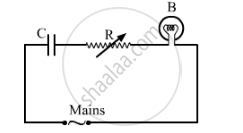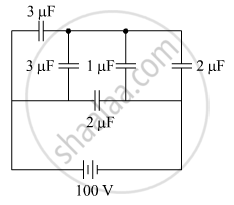Advertisements
Advertisements
प्रश्न
A parallel-plate capacitor having plate area 20 cm2 and separation between the plates 1⋅00 mm is connected to a battery of 12⋅0 V. The plates are pulled apart to increase the separation to 2⋅0 mm. (a) Calculate the charge flown through the circuit during the process. (b) How much energy is absorbed by the battery during the process? (c) Calculate the stored energy in the electric field before and after the process. (d) Using the expression for the force between the plates, find the work done by the person pulling the plates apart. (e) Show and justify that no heat is produced during this transfer of charge as the separation is increased.
उत्तर
Given :
Area, A = 20 `"cm"^2 = 2 xx 10^-3 "m"^2`
Separation , `d_1 = 1 "mm" = 10^-3 "m"`
Initial Capacitance of the capacitor ;
`C_1 = (∈_0A)/d_1`
`C_1 = (8.88 xx 10^-12 xx 20 xx 10^-4)/(1 xx 10^-3)`
`C_1 = 1.776 xx 10^-11 "F"`
Final capacitance of the capacitor :
`C_2 = C_1/2` (because `d_2 = d_1/2`)
(a) Charge flown through the circuit :
`Q = C_1V - C_2V`
`Q = (C_1 - C_2)V`
`Q = 1.776/2 xx 10^-11 xx 12.0`
`Q = 1.06 xx 10^-10 C`
(b) Energy absorbed by the battery :
`E = QV = 1.06 xx 10^-10 xx 12`
`E = 12.72 xx 10^-10 J`
(c) Energy stored before the process, `E_i = 1/2C_1V^2`
⇒ `E_i = 1/2 xx 1.776 xx 10^-11 xx (12)^2`
⇒ `E_i = 12.7 xx 10^-10 J`
Energy stored after the process, `E_f = 1/2 C_2V^2`
⇒ `E_f = 1/2 xx 1.776/2 xx 10^-11 xx (12)^2`
⇒ `E_f = 6.35 xx 10^-10 J`
(d) Work done, W = Force × Distance
= `1/2 xx (Q^2)/(∈_0A) xx 1 xx 10^(-3)`
= `1/2 xx (12 xx 12 xx ∈_0 xx ∈_0 xx 10^(-3))/(∈_0 xx 2 xx 10^(-3))`
⇒ W = 6.35 × 10−10 J
(e) Transfer of charge as the separation is increased
`ΔE = E_i - E_f`
W = 6.35 × 10−10 J
⇒ ΔE = W
APPEARS IN
संबंधित प्रश्न
Two capacitors of unknown capacitances C1 and C2 are connected first in series and then in parallel across a battery of 100 V. If the energy stored in the two combinations is 0.045 J and 0.25 J respectively, determine the value of C1 and C2. Also calculate the charge on each capacitor in parallel combination.
A capacitor 'C', a variable resistor 'R' and a bulb 'B' are connected in series to the ac mains in circuit as shown. The bulb glows with some brightness. How will the glow of the bulb change if (i) a dielectric slab is introduced between the plates of the capacitor, keeping resistance R to be the same; (ii) the resistance R is increased keeping the same capacitance?

Three capacitors each of capacitance 9 pF are connected in series.
- What is the total capacitance of the combination?
- What is the potential difference across each capacitor if the combination is connected to a 120 V supply?
An electrical technician requires a capacitance of 2 µF in a circuit across a potential difference of 1 kV. A large number of 1 µF capacitors are available to him each of which can withstand a potential difference of not more than 400 V. Suggest a possible arrangement that requires the minimum number of capacitors.
The plates of a parallel-plate capacitor are given equal positive charges. What will be the potential difference between the plates? What will be the charges on the facing surfaces and on the outer surfaces?
If the capacitors in the previous question are joined in parallel, the capacitance and the breakdown voltage of the combination will be
Each plate of a parallel plate capacitor has a charge q on it. The capacitor is now connected to a batter. Now,
(a) the facing surfaces of the capacitor have equal and opposite charges
(b) the two plates of the capacitor have equal and opposite charges
(c) the battery supplies equal and opposite charges to the two plates
(d) the outer surfaces of the plates have equal charges
The separation between the plates of a charged parallel-plate capacitor is increased. Which of the following quantities will change?
(a) Charge on the capacitor
(b) Potential difference across the capacitor
(c) Energy of the capacitor
(d) Energy density between the plates
A parallel-plate capacitor is connected to a battery. A metal sheet of negligible thickness is placed between the plates. The sheet remains parallel to the plates of the capacitor.
The plates of a capacitor are 2⋅00 cm apart. An electron-proton pair is released somewhere in the gap between the plates and it is found that the proton reaches the negative plate at the same time as the electron reaches the positive plate. At what distance from the negative plate was the pair released?
Find the charges on the four capacitors of capacitances 1 μF, 2 μF, 3 μF and 4 μF shown in the figure.


The figure shows a network of five capacitors connected to a 100 V supply. Calculate the total energy stored in the network.
An ac circuit consists of a series combination of circuit elements X and Y. The current is ahead of the voltage in phase by `pi/4`. If element X is a pure resistor of 100 Ω,
(a) name the circuit element Y.
(b) calculate the rms value of current, if rms of voltage is 141 V.
(c) what will happen if the ac source is replaced by a dc source
Two parallel plate capacitors X and Y, have the same area of plates and same separation between plates. X has air and Y with dielectric of constant 2, between its plates. They are connected in series to a battery of 12 V. The ratio of electrostatic energy stored in X and Y is ______.
Three capacitors each of 4 µF are to be connected in such a way that the effective capacitance is 6µF. This can be done by connecting them:
The total charge on the system of capacitors C1 = 1 µF, C2 = 2 µF, C3 = 4 µF and C4 = 3 µF connected in parallel is ______. (Assume a battery of 20 V is connected to the combination)
Three capacitors of capacitances 2 pF, 3 pF and 4 pF are connected in parallel. What is the total capacitance of the combination?
